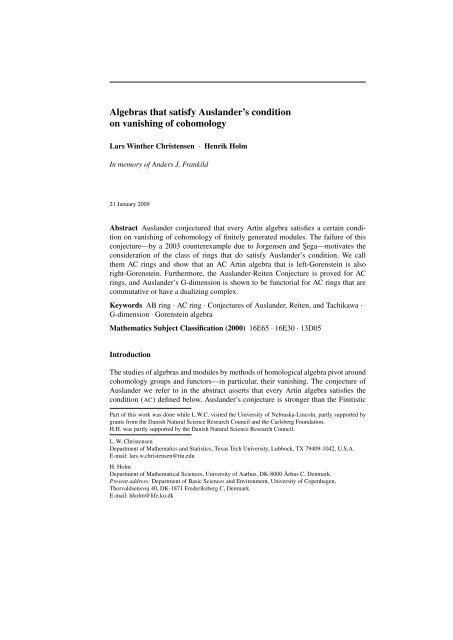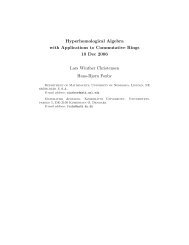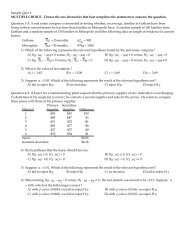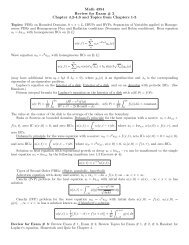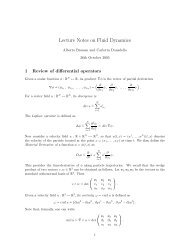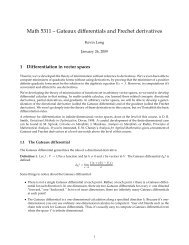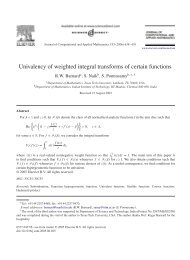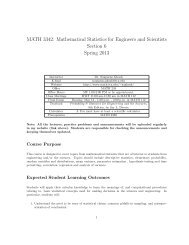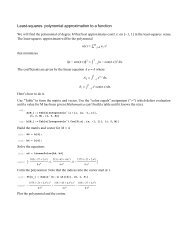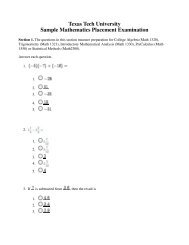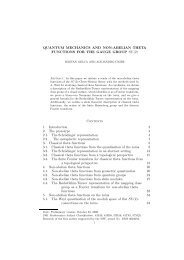Algebras that satisfy Auslander's condition on vanishing of ...
Algebras that satisfy Auslander's condition on vanishing of ...
Algebras that satisfy Auslander's condition on vanishing of ...
You also want an ePaper? Increase the reach of your titles
YUMPU automatically turns print PDFs into web optimized ePapers that Google loves.
<str<strong>on</strong>g>Algebras</str<strong>on</strong>g> <str<strong>on</strong>g>that</str<strong>on</strong>g> <str<strong>on</strong>g>satisfy</str<strong>on</strong>g> Auslander’s <str<strong>on</strong>g>c<strong>on</strong>diti<strong>on</strong></str<strong>on</strong>g><strong>on</strong> <strong>vanishing</strong> <strong>of</strong> cohomologyLars Winther Christensen · Henrik HolmIn memory <strong>of</strong> Anders J. Frankild21 January 2009Abstract Auslander c<strong>on</strong>jectured <str<strong>on</strong>g>that</str<strong>on</strong>g> every Artin algebra satisfies a certain <str<strong>on</strong>g>c<strong>on</strong>diti<strong>on</strong></str<strong>on</strong>g><strong>on</strong> <strong>vanishing</strong> <strong>of</strong> cohomology <strong>of</strong> finitely generated modules. The failure <strong>of</strong> thisc<strong>on</strong>jecture—by a 2003 counterexample due to Jorgensen and Şega—motivates thec<strong>on</strong>siderati<strong>on</strong> <strong>of</strong> the class <strong>of</strong> rings <str<strong>on</strong>g>that</str<strong>on</strong>g> do <str<strong>on</strong>g>satisfy</str<strong>on</strong>g> Auslander’s <str<strong>on</strong>g>c<strong>on</strong>diti<strong>on</strong></str<strong>on</strong>g>. We callthem AC rings and show <str<strong>on</strong>g>that</str<strong>on</strong>g> an AC Artin algebra <str<strong>on</strong>g>that</str<strong>on</strong>g> is left-Gorenstein is alsoright-Gorenstein. Furthermore, the Auslander-Reiten C<strong>on</strong>jecture is proved for ACrings, and Auslander’s G-dimensi<strong>on</strong> is shown to be functorial for AC rings <str<strong>on</strong>g>that</str<strong>on</strong>g> arecommutative or have a dualizing complex.Keywords AB ring · AC ring · C<strong>on</strong>jectures <strong>of</strong> Auslander, Reiten, and Tachikawa ·G-dimensi<strong>on</strong> · Gorenstein algebraMathematics Subject Classificati<strong>on</strong> (2000) 16E65 · 16E30 · 13D05Introducti<strong>on</strong>The studies <strong>of</strong> algebras and modules by methods <strong>of</strong> homological algebra pivot aroundcohomology groups and functors—in particular, their <strong>vanishing</strong>. The c<strong>on</strong>jecture <strong>of</strong>Auslander we refer to in the abstract asserts <str<strong>on</strong>g>that</str<strong>on</strong>g> every Artin algebra satisfies the<str<strong>on</strong>g>c<strong>on</strong>diti<strong>on</strong></str<strong>on</strong>g> (AC) defined below. Auslander’s c<strong>on</strong>jecture is str<strong>on</strong>ger than the FinitisticPart <strong>of</strong> this work was d<strong>on</strong>e while L.W.C. visited the University <strong>of</strong> Nebraska-Lincoln, partly supported bygrants from the Danish Natural Science Research Council and the Carlsberg Foundati<strong>on</strong>.H.H. was partly supported by the Danish Natural Science Research Council.L. W. ChristensenDepartment <strong>of</strong> Mathematics and Statistics, Texas Tech University, Lubbock, TX 79409-1042, U.S.A.E-mail: lars.w.christensen@ttu.eduH. HolmDepartment <strong>of</strong> Mathematical Sciences, University <strong>of</strong> Aarhus, DK-8000 Århus C, Denmark.Present address: Department <strong>of</strong> Basic Sciences and Envir<strong>on</strong>ment, University <strong>of</strong> Copenhagen,Thorvaldsensvej 40, DK-1871 Frederiksberg C, DenmarkE-mail: hholm@life.ku.dk
2 L. W. Christensen, H. HolmDimensi<strong>on</strong> C<strong>on</strong>jecture and several other l<strong>on</strong>g-standing c<strong>on</strong>jectures for finite dimensi<strong>on</strong>alalgebras—including the Auslander-Reiten and Nakayama C<strong>on</strong>jectures; see [1,ch. V], [21], and [42]. In [29] Jorgensen and Şega exhibit a finite dimensi<strong>on</strong>al algebra<str<strong>on</strong>g>that</str<strong>on</strong>g> fails to <str<strong>on</strong>g>satisfy</str<strong>on</strong>g> (AC), thereby overturning Auslander’s c<strong>on</strong>jecture. This makesrelevant a subtle point: <strong>on</strong>e knows <str<strong>on</strong>g>that</str<strong>on</strong>g> if all finite dimensi<strong>on</strong>al algebras had satisfied(AC), then they would all have finite finitistic dimensi<strong>on</strong>, but it is not known if agiven algebra <str<strong>on</strong>g>that</str<strong>on</strong>g> satisfies (AC) must have finite finitistic dimensi<strong>on</strong>. What is known,is <str<strong>on</strong>g>that</str<strong>on</strong>g> a finite dimensi<strong>on</strong>al algebra Λ over a field k has finite finitistic dimensi<strong>on</strong> ifthe enveloping algebra Λ e = Λ ⊗ k Λ ◦ satisfies (AC); see [21, sec. 1].Such observati<strong>on</strong>s motivate the study <strong>of</strong> AC rings, <str<strong>on</strong>g>that</str<strong>on</strong>g> is, left-noetherian rings A<str<strong>on</strong>g>that</str<strong>on</strong>g> <str<strong>on</strong>g>satisfy</str<strong>on</strong>g> Auslander’s <str<strong>on</strong>g>c<strong>on</strong>diti<strong>on</strong></str<strong>on</strong>g> <strong>on</strong> <strong>vanishing</strong> <strong>of</strong> cohomology:(AC) For every finitely generated left A-module M there exists an integer b M 0 such <str<strong>on</strong>g>that</str<strong>on</strong>g> for everyfinitely generated left A-module N <strong>on</strong>e has: Ext ≫0A (M,N) = 0 implies Ext>b MA (M,N) = 0.For certain commutative rings this study was initiated by Huneke and Jorgensen [23].In this paper we give special attenti<strong>on</strong> to problems from Auslander’s work in representati<strong>on</strong>theory—including the c<strong>on</strong>jectures menti<strong>on</strong>ed above.∗ ∗ ∗Auslander and Reiten c<strong>on</strong>jectured [4] <str<strong>on</strong>g>that</str<strong>on</strong>g> a finitely generated module M over anArtin algebra Λ is projective if ExtΛ i (M,M) = 0 = Exti Λ (M,Λ) for all i 1. See AppendixA for a brief survey <strong>of</strong> this and related c<strong>on</strong>jectures. To facilitate the discussi<strong>on</strong>,we distinguish between c<strong>on</strong>jectures (about all algebras) and <str<strong>on</strong>g>c<strong>on</strong>diti<strong>on</strong></str<strong>on</strong>g>s (<strong>on</strong> a singlealgebra). C<strong>on</strong>sider the following <str<strong>on</strong>g>c<strong>on</strong>diti<strong>on</strong></str<strong>on</strong>g> <strong>on</strong> a left-noetherian ring A:(ARC) Every finitely generated left A-module M with Ext 1A (M,M ⊕A) = 0 is projective.The Auslander-Reiten C<strong>on</strong>jecture can now be restated as “All Artin algebras <str<strong>on</strong>g>satisfy</str<strong>on</strong>g>(ARC)”. At the level <strong>of</strong> c<strong>on</strong>jectures, Auslander’s c<strong>on</strong>jecture is str<strong>on</strong>ger than the FinitisticDimensi<strong>on</strong> C<strong>on</strong>jecture, and <str<strong>on</strong>g>that</str<strong>on</strong>g> <strong>on</strong>e implies the Auslander-Reiten C<strong>on</strong>jecture.Thus, had all algebras satisfied (AC), then <strong>on</strong>e would know <str<strong>on</strong>g>that</str<strong>on</strong>g> all algebras <str<strong>on</strong>g>satisfy</str<strong>on</strong>g>(ARC). Theorem A below gives new insight at the level <strong>of</strong> <str<strong>on</strong>g>c<strong>on</strong>diti<strong>on</strong></str<strong>on</strong>g>s: it implies <str<strong>on</strong>g>that</str<strong>on</strong>g>any given AC ring satisfies (ARC). Our pro<strong>of</strong> <strong>of</strong> Theorem A avoids c<strong>on</strong>siderati<strong>on</strong>s<strong>of</strong> finitistic dimensi<strong>on</strong>s, and it remains unknown if every AC Artin algebra has finitefinitistic dimensi<strong>on</strong>.Theorem A Let A be a left-noetherian ring <str<strong>on</strong>g>that</str<strong>on</strong>g> satisfies (AC), and let M be a finitelygenerated left A-module. If <strong>on</strong>e has Ext ≫0A(M,M) = 0 and Ext1A(M,A) = 0, then Mis projective.This theorem is a special case <strong>of</strong> our main result 2.3. Notice <str<strong>on</strong>g>that</str<strong>on</strong>g> the <strong>vanishing</strong> <str<strong>on</strong>g>c<strong>on</strong>diti<strong>on</strong></str<strong>on</strong>g>simposed <strong>on</strong> M in Theorem A appear to be weaker than those in the Auslander-Reiten C<strong>on</strong>jecture; we discuss this in 2.4.It is an open questi<strong>on</strong>—also due to Auslander and Reiten [5]—whether an Artinalgebra is left-Gorenstein if and <strong>on</strong>ly if it is right-Gorenstein. This is known as theGorenstein Symmetry Questi<strong>on</strong>; the next partial answer is proved in 3.2 and 3.5.
<str<strong>on</strong>g>Algebras</str<strong>on</strong>g> <str<strong>on</strong>g>that</str<strong>on</strong>g> <str<strong>on</strong>g>satisfy</str<strong>on</strong>g> Auslander’s <str<strong>on</strong>g>c<strong>on</strong>diti<strong>on</strong></str<strong>on</strong>g> <strong>on</strong> <strong>vanishing</strong> <strong>of</strong> cohomology 3Theorem B Let A be a two-sided noetherian ring. If A and A ◦ <str<strong>on</strong>g>satisfy</str<strong>on</strong>g> (AC) and(1) A is an Artin algebra, or(2) A has a dualizing complex (as defined in [13]),then id A A < ∞ if and <strong>on</strong>ly if id A ◦ A < ∞ (whence, id A A = id A ◦ A by [26]).We do not know if every Artin algebra has a dualizing complex, but every finitedimensi<strong>on</strong>al k-algebra does have <strong>on</strong>e, cf. 3.4.To study the module category <strong>of</strong> a Gorenstein ring, Auslander and Bridger [2]introduced the so-called G-dimensi<strong>on</strong>. A finitely generated left module M ≠ 0 over atwo-sided noetherian ring A is <strong>of</strong> G-dimensi<strong>on</strong> 0 if it is reflexive and Ext i A (M,A) =0 = Ext i A ◦(Hom A(M,A),A) for all i 1. Implicit in their work is the questi<strong>on</strong> whetherall two-sided noetherian rings A <str<strong>on</strong>g>satisfy</str<strong>on</strong>g> the <str<strong>on</strong>g>c<strong>on</strong>diti<strong>on</strong></str<strong>on</strong>g>:(GC) Every finitely generated left A-module M ≠ 0 with Ext 1A (M,A) = 0 is <strong>of</strong> G-dimensi<strong>on</strong> 0.By another example <strong>of</strong> Jorgensen and Şega [30], also this questi<strong>on</strong> has a negative answer,even for commutative local finite dimensi<strong>on</strong>al k-algebras. The following partialanswer is part <strong>of</strong> 4.4.Theorem C Let A be a two-sided noetherian ring <str<strong>on</strong>g>that</str<strong>on</strong>g> has a dualizing complex (asdefined in [13]) or is commutative. If A satisfies (AC), then it satisfies (GC).By work <strong>of</strong> Huneke, Şega, and Vraciu [25], the Auslander-Reiten C<strong>on</strong>jectureholds for commutative noetherian local rings with radical cube zero, and the counterexamplesin [29,30] show <str<strong>on</strong>g>that</str<strong>on</strong>g> such rings need not <str<strong>on</strong>g>satisfy</str<strong>on</strong>g> (AC) or (GC). Here is asummary in diagram form:(2)(AC)(GC)(4)|(3)\ (5) −(1)(ARC)(1) [2, thm. (4.13) and (4.20)] and [29, cor. 3.3(1)];(2) Theorem C, for two-sided noetherian rings <str<strong>on</strong>g>that</str<strong>on</strong>g>have a dualizing complex or are commutative;(3) [29, cor. 3.3(2)] and [25, thm. 4.1(1)];(4) Theorem A;(5) [30, thm. 1.7] and [25, thm. 4.1(1)].Theorems A, B, and C are proved in Secti<strong>on</strong>s 2–4. In Secti<strong>on</strong> 5 we discuss simpleprocedures for generating new AC rings from existing <strong>on</strong>es.Appendix A recapitulates certain aspects <strong>of</strong> the homological c<strong>on</strong>jectures for finitedimensi<strong>on</strong>al k-algebras in order to place the present work in proper perspective.Theorem C relies <strong>on</strong> a technical result, Lemma 4.1, which owes an intellectualdebt to work <strong>of</strong> Huneke and Jorgensen [23]. Combined with other techniques, 4.1yields new pro<strong>of</strong>s and modest generalizati<strong>on</strong>s <strong>of</strong> the main result in [23] <strong>on</strong> symmetricExt-<strong>vanishing</strong> over commutative noetherian Gorenstein AC rings; these are given inAppendix B.Many <strong>of</strong> our pro<strong>of</strong>s use the derived category over a ring. In the next secti<strong>on</strong> werecall the (standard) notati<strong>on</strong> used throughout the paper.
4 L. W. Christensen, H. Holm1 PrerequisitesThroughout, A denotes a left-noetherian ring which is an algebra over a commutativering k (e.g. k = Z), and A ◦ is the opposite ring. The letter k denotes a field, and Λdenotes a finite dimensi<strong>on</strong>al k-algebra or, more generally, an Artin algebra.1.1 Modules (over A or Λ) are left modules, unless otherwise specified. We writeMod(A) for the category <strong>of</strong> all A-modules and mod(A) for the full subcategory <strong>of</strong>finitely generated A-modules.For M and N in Mod(A), the notati<strong>on</strong> Ext nA (M,N) = 0 means <str<strong>on</strong>g>that</str<strong>on</strong>g> Exti A (M,N)vanish for all i n. We write Ext ≫0A(M,N) = 0 if ExtnA(M,N) = 0 for some n. ForM in mod(A), a number b M with the property required in (AC), see the Introducti<strong>on</strong>,is called an Auslander bound for M. We also c<strong>on</strong>sider rings A over which there is auniform Auslander bound for all M in mod(A), i.e. rings <str<strong>on</strong>g>that</str<strong>on</strong>g> <str<strong>on</strong>g>satisfy</str<strong>on</strong>g>:(UAC) There is a b 0 such <str<strong>on</strong>g>that</str<strong>on</strong>g> for all finitely generated A-modules M and N <strong>on</strong>e has:Ext ≫0A (M,N) = 0 implies Ext>b A (M,N) = 0.In [23] the smallest integer b with this property is called the Ext-index <strong>of</strong> A.1.2 A complex <strong>of</strong> A-modules is graded homologically,∂v+1M ∂vM = ··· −→ M v+1 −−−→ M M v −−→ M v−1 −→ ··· ,and, for short, called an A-complex. The suspensi<strong>on</strong> <strong>of</strong> M is the complex ΣM with(ΣM) v = M v−1 and ∂ ΣM = −∂ M . With the notati<strong>on</strong>C v (M) = Coker∂ M v+1 and Z v (M) = Ker∂ M v ,s<strong>of</strong>t truncati<strong>on</strong>s <strong>of</strong> M are defined asM ⊂u = 0 → C u (M) → M u−1 → M u−2 → ··· andM ⊃w = ··· → M w+2 → M w+1 → Z w (M) → 0.The hard truncati<strong>on</strong>s <strong>of</strong> M are defined asM u = 0 → M u → M u−1 → ··· and M w = ··· → M w+1 → M w → 0.We say <str<strong>on</strong>g>that</str<strong>on</strong>g> M is left-bounded if M v = 0 for v ≫ 0, right-bounded if M v = 0 for v ≪ 0,and bounded if M v = 0 for |v| ≫ 0. If the homology complex H(M) is (left/right-)bounded, then M is said to be homologically (left/right-)bounded. The notati<strong>on</strong> supMand infM is used for the supremum and infimum <strong>of</strong> the set { v ∈ Z | H v (M) ≠ 0 } withthe c<strong>on</strong>venti<strong>on</strong>s <str<strong>on</strong>g>that</str<strong>on</strong>g> sup∅ = −∞ and inf∅ = ∞.A morphism α <strong>of</strong> complexes is called a quasiisomorphism, and marked by thesymbol ≃, if it induces an isomorphism <strong>on</strong> the level <strong>of</strong> homology. The mapping c<strong>on</strong>e<strong>of</strong> α is denoted C<strong>on</strong>eα. Recall <str<strong>on</strong>g>that</str<strong>on</strong>g> the complex C<strong>on</strong>eα is exact if and <strong>on</strong>ly if α isa quasiisomorphism. Quasiisomorphisms between A-complexes are isomorphisms inthe derived category D(A). Isomorphisms in D(A) are also marked by the symbol ≃.
<str<strong>on</strong>g>Algebras</str<strong>on</strong>g> <str<strong>on</strong>g>that</str<strong>on</strong>g> <str<strong>on</strong>g>satisfy</str<strong>on</strong>g> Auslander’s <str<strong>on</strong>g>c<strong>on</strong>diti<strong>on</strong></str<strong>on</strong>g> <strong>on</strong> <strong>vanishing</strong> <strong>of</strong> cohomology 51.3 We use standard notati<strong>on</strong>, RHom A (−,−) and − ⊗ L A −, for the right derived Homfunctor and the left derived tensor product functor; see [41, ch. 10]. Recall <str<strong>on</strong>g>that</str<strong>on</strong>g> for allA-modules M and N and all A ◦ -modules K there are isomorphismsExt i A (M,N) ∼ = H −i RHom A (M,N) and Tor A i (K,M) ∼ = H i (K ⊗ L A M).Resoluti<strong>on</strong>s <strong>of</strong> complexes, projective dimensi<strong>on</strong> (pd), and injective dimensi<strong>on</strong>(id) are treated in [9]. We make frequent use <strong>of</strong> the following: Every homologicallyleft-bounded complex has a left-bounded injective resoluti<strong>on</strong>; every homologicallyright-bounded complex M has a right-bounded free resoluti<strong>on</strong> L, and if M has degreewisefinitely generated homology, then L can be taken to be degreewise finitelygenerated. In particular, every homologically right-bounded complex M has a projectiveresoluti<strong>on</strong> and the projective dimensi<strong>on</strong> is given as:pd R M = inf{sup{i ∈ Z | P i ≠ 0} | P is a projective resoluti<strong>on</strong> <strong>of</strong> M }.The injective dimensi<strong>on</strong> <strong>of</strong> a complex is defined similarly.Lemma 1.4 Let X and Y be A-complexes. Assume <str<strong>on</strong>g>that</str<strong>on</strong>g> X is homologically rightboundedand let P −−→ ≃ X be a projective resoluti<strong>on</strong>; assume <str<strong>on</strong>g>that</str<strong>on</strong>g> Y is homologicallyleft-bounded and let Y −−→ ≃ I be an injective resoluti<strong>on</strong>. If RHom A (X,Y ) is homologicallybounded and s supX, then Ext 1A (C s(P),Z v (I)) = 0 for all 0 ≫ v.Pro<strong>of</strong> Let s supX and note <str<strong>on</strong>g>that</str<strong>on</strong>g> P ⊂s ≃ X in D(A). Applicati<strong>on</strong> <strong>of</strong> RHom A (−,Y ) tothe distinguished triangle in D(A),P s−1 −→ P ⊂s −→ Σ s C s (P) −→,induces a l<strong>on</strong>g exact sequence <strong>of</strong> homology modules, which yields isomorphismsH v+1 RHom A (P s−1 ,Y ) ∼ = H v RHom A (Σ s C s (P),Y )∼= H v+s RHom A (C s (P),Y ),for v + 1 < infRHom A (X,Y ). Obviously, pd A (P s−1 ) s − 1 and, therefore,infRHom A (P s−1 ,Y ) infY − (s − 1);see [9, thm. 2.4.P]. Set w = min{infY,infRHom A (X,Y ) + s − 1}; it follows <str<strong>on</strong>g>that</str<strong>on</strong>g>(1.4.1) H v RHom A (C s (P),Y ) = 0 for all v < w.If v w, then v infY , so there is an isomorphism <strong>of</strong> module functorsExt i A (−,Z v(I)) ∼ = H v−i RHom A (−,Y )for every i > 0, cf. [12, pro<strong>of</strong> <strong>of</strong> lem. (6.1.12)]. In particular,Ext i A (C s(P),Z v (I)) ∼ = H v−i RHom A (C s (P),Y ) = 0for all i > 0, where the last equality follows from (1.4.1).⊓⊔
6 L. W. Christensen, H. Holm2 The Auslander-Reiten C<strong>on</strong>jectureIn this secti<strong>on</strong> we prove Theorem A from the Introducti<strong>on</strong>. We open with a technicallemma.Lemma 2.1 Assume <str<strong>on</strong>g>that</str<strong>on</strong>g> A satisfies (AC). Let U be an exact A-complex and C be afinitely generated A-module. If(a) U v is finitely generated for all v ≫ 0,(b) Ext 1A (C,U v) = 0 for all v ∈ Z, and(c) there exists a w ∈ Z such <str<strong>on</strong>g>that</str<strong>on</strong>g> Ext ≫0A (C,Z w(U)) = 0,then Ext 1A (C,Z v(U)) = 0 for all v ∈ Z. In particular, Hom A (C,U) is exact.Pro<strong>of</strong> Apply Hom A (C,−) to 0 → Z v+1 (U) → U v+1 → Z v (U) → 0, then (b) yields(2.1.1) Ext i A (C,Z v(U)) ∼ = Ext i+nA (C,Z v+n(U)) for all v ∈ Z, i > 0, and n 0.If v w, then Ext ≫0A(C,Z v(U)) = 0. Indeed, (2.1.1) yields isomorphismsExt i+v−wA(C,Z v (U)) ∼ = Ext i+(v−w) (C,Z w+(v−w) (U)) ∼ = Ext i A (C,Z w(U)),Afor i > 0, and the right-most Ext group vanishes by (c) for i ≫ 0. By (a) there is aninteger t such <str<strong>on</strong>g>that</str<strong>on</strong>g> Z v (U) is finitely generated for v t. As A satisfies (AC),(2.1.2) Ext >bA(C,Z v(U)) = 0 for all v m = max{t,w},where b is an Auslander bound for C. To see <str<strong>on</strong>g>that</str<strong>on</strong>g> Ext 1A (C,Z v(U)) = 0 for all v,c<strong>on</strong>sider the cases v m − b and v m − b separately. In the following, let i > 0. Ifv m − b, thenExt i A (C,Z v(U)) ∼ = Ext i+bA (C,Z v+b(U)) = 0by (2.1.1) and (2.1.2). If v m − b then, in particular, m − v b 0, and thusExt i A (C,Z v(U)) ∼ = Ext i+(m−v)A(C,Z v+(m−v) (U)) = Ext i+m−vA(C,Z m (U)) = 0;again by (2.1.1) and (2.1.2).Remark 2.2 The lemma above may fail for rings <str<strong>on</strong>g>that</str<strong>on</strong>g> do not <str<strong>on</strong>g>satisfy</str<strong>on</strong>g> (AC). Indeed,<strong>on</strong>e counterexample to Auslander’s c<strong>on</strong>jecture is a commutative local self-injectivefinite dimensi<strong>on</strong>al k-algebra R for which there exist finitely generated modules C andZ, such <str<strong>on</strong>g>that</str<strong>on</strong>g> Ext i R (C,Z) ≠ 0 if and <strong>on</strong>ly if i = 0,1; see [29, cor. 3.3.(1)]. Because R isself-injective, the modules C and Z have G-dimensi<strong>on</strong> 0; see [2, prop. 3.8]. Let U bea complete projective resoluti<strong>on</strong> <strong>of</strong> Z, see [12, thm. (4.1.4)], then U and C <str<strong>on</strong>g>satisfy</str<strong>on</strong>g> therequirements in Lemma 2.1, but Ext 1 R (C,Z) ≠ 0.Theorem A in the Introducti<strong>on</strong> is an immediate c<strong>on</strong>sequence <strong>of</strong> the next result.Theorem 2.3 Assume <str<strong>on</strong>g>that</str<strong>on</strong>g> A satisfies (AC), and let M be an A-complex. If M hasbounded and degreewise finitely generated homology, and RHom A (M,M ⊕ A) is homologicallybounded, then M has finite projective dimensi<strong>on</strong> given bypd A M = −infRHom A (M,A) < ∞.⊓⊔
<str<strong>on</strong>g>Algebras</str<strong>on</strong>g> <str<strong>on</strong>g>that</str<strong>on</strong>g> <str<strong>on</strong>g>satisfy</str<strong>on</strong>g> Auslander’s <str<strong>on</strong>g>c<strong>on</strong>diti<strong>on</strong></str<strong>on</strong>g> <strong>on</strong> <strong>vanishing</strong> <strong>of</strong> cohomology 7Pro<strong>of</strong> We may assume <str<strong>on</strong>g>that</str<strong>on</strong>g> M ≄ 0 in D(A). We need <strong>on</strong>ly prove <str<strong>on</strong>g>that</str<strong>on</strong>g> pd A M is finite,then a standard argument yields the equality displayed above; see the pro<strong>of</strong> <strong>of</strong> [12,prop. (2.3.10)]. Take a right-bounded resoluti<strong>on</strong> L −−→ ≃ M by finitely generated freeA-modules and c<strong>on</strong>sider the integers = max{−infRHom A (M,A), supM }.We will show <str<strong>on</strong>g>that</str<strong>on</strong>g> the cokernel C s (L) is projective, i.e. Ext 1 A (C s(L),C s+1 (L)) = 0.To this end, take an injective resoluti<strong>on</strong> M −−→ ≃ I with I v = 0 for v > supM; see [9,cor. 2.7.I]. Since RHom A (M,M) is homologically bounded, there is by Lemma 1.4an integer u infM such <str<strong>on</strong>g>that</str<strong>on</strong>g>(2.3.1) Ext 1A (C s(L),Z u (I)) = 0.There are quasiisomorphisms≃L −−→ M≃ −−→ I≃←−− I ⊃u ,so by [9, 1.4.P] there is a quasiisomorphism α : L −−→ I ⊃u . We claim <str<strong>on</strong>g>that</str<strong>on</strong>g> Lemma 2.1applies to U = C<strong>on</strong>eα and the finitely generated module C = C s (L). Requirement2.1(a) is clearly met, and so is 2.1(c), as C<strong>on</strong>eα is right-bounded. To verify 2.1(b) itsuffices, in view <strong>of</strong> (2.3.1), to show <str<strong>on</strong>g>that</str<strong>on</strong>g> Ext 1A (C s(L),A) = 0, and this follows asExt i A (C s(L),A) ∼ = H −(i+s) RHom A (M,A) = 0 for all i > 0;cf. [12, prf. <strong>of</strong> (4.3.9)]. In particular, Lemma 2.1 gives Ext 1A (C s(L),Z s+1 (C<strong>on</strong>eα)) =0, and by the choice <strong>of</strong> I we have Z s+1 (C<strong>on</strong>eα) = C s+1 (L). ⊓⊔Remark 2.4 The <str<strong>on</strong>g>c<strong>on</strong>diti<strong>on</strong></str<strong>on</strong>g> (ARC) and Theorem A in the Introducti<strong>on</strong> draw identicalc<strong>on</strong>clusi<strong>on</strong>s from apparently different assumpti<strong>on</strong>s <strong>on</strong> a finitely generated A-moduleM, namely:(a) Ext 1A(M,M ⊕ A) = 0; compared to(b) Ext ≫0 (M,M) = 0 and Ext1(M,A) = 0.AAClearly, (a) implies (b). We do not know if the two are equivalent, not even if A iscommutative local and Gorenstein. Theorem 2.3 shows <str<strong>on</strong>g>that</str<strong>on</strong>g> if A is AC, then (a) and(b) are equivalent. A much str<strong>on</strong>ger result holds if A is commutative local and completeintersecti<strong>on</strong>, then Ext 1A(M,A) = 0 and <strong>vanishing</strong> <strong>of</strong> Ext2i A (M,M) for a singleinteger i > 0 implies <str<strong>on</strong>g>that</str<strong>on</strong>g> M is free; see [7, thm. 4.2]. If A is commutative local (ACor not) with radical cube zero, then <strong>vanishing</strong> <strong>of</strong> Ext i A (M,M ⊕A) for four c<strong>on</strong>secutivevalues <strong>of</strong> i 2 implies <str<strong>on</strong>g>that</str<strong>on</strong>g> M is free; see [25, thm. 4.1].≃3 The Gorenstein Symmetry Questi<strong>on</strong>For a two-sided noetherian ring A, we do not know if Auslander’s <str<strong>on</strong>g>c<strong>on</strong>diti<strong>on</strong></str<strong>on</strong>g> is symmetric,<str<strong>on</strong>g>that</str<strong>on</strong>g> is, if A and A ◦ <str<strong>on</strong>g>satisfy</str<strong>on</strong>g> (AC) simultaneously. For Artin algebras, however,the uniform <str<strong>on</strong>g>c<strong>on</strong>diti<strong>on</strong></str<strong>on</strong>g> (UAC), defined in 1.1, is symmetric.
8 L. W. Christensen, H. HolmObservati<strong>on</strong> 3.1 Let Λ be an Artin algebra. The can<strong>on</strong>ical duality functorD: mod(Λ ◦ ) −→ mod(Λ),see [6, thm. II.3.3], provides isomorphismsExt i Λ ◦(M,N) ∼ = Ext i Λ (D(N),D(M))for all finitely generated Λ ◦ -modules M and N and all integers i. This shows <str<strong>on</strong>g>that</str<strong>on</strong>g> Λ ◦satisfies (UAC) if and <strong>on</strong>ly if Λ does.Auslander and Reiten [5] raise the questi<strong>on</strong> whether an Artin algebra is left-Gorenstein if and <strong>on</strong>ly if it is right-Gorenstein. The next propositi<strong>on</strong> c<strong>on</strong>tains part(1) <strong>of</strong> Theorem B from the Introducti<strong>on</strong>, and it uses [5, prop. 6.10] to establish an“algebra-wise” relati<strong>on</strong> between Auslander’s c<strong>on</strong>jecture and the Finitistic Dimensi<strong>on</strong>C<strong>on</strong>jecture.Propositi<strong>on</strong> 3.2 Let Λ be an Artin algebra <str<strong>on</strong>g>that</str<strong>on</strong>g> satisfies (AC). If id Λ Λ is finite, thenid Λ ◦ Λ and the finitistic dimensi<strong>on</strong> <strong>of</strong> Λ (<strong>on</strong> both sides) 1 is finite.Pro<strong>of</strong> The finitely generated Λ-module D(Λ Λ ) is injective. Set n = id Λ Λ, thenExt >nΛ (D(Λ Λ ),D(Λ Λ ) ⊕ Λ Λ) = 0,so it follows from Theorem 2.3 <str<strong>on</strong>g>that</str<strong>on</strong>g> pd Λ D(Λ Λ ) is at most n. For every finitely generatedΛ ◦ -module N, the isomorphism from Observati<strong>on</strong> 3.1 yieldsExt i Λ ◦(N Λ ,Λ Λ ) ∼ = Ext i Λ (D(Λ Λ ),D(N Λ )) = 0 for i > n,whence id Λ ◦ Λ n. Now the finitistic dimensi<strong>on</strong> <strong>of</strong> Λ is finite by [5, prop. 6.10].⊓⊔Remark 3.3 For an Artin algebra Λ <str<strong>on</strong>g>that</str<strong>on</strong>g> satisfies (UAC), it follows from Observati<strong>on</strong>3.1 and Propositi<strong>on</strong> 3.2 <str<strong>on</strong>g>that</str<strong>on</strong>g> id Λ Λ is finite if and <strong>on</strong>ly if id Λ ◦ Λ is finite.Nagata’s regular ring <strong>of</strong> infinite Krull dimensi<strong>on</strong> [35, ex. 1, p. 203] is an example<strong>of</strong> a commutative noetherian ring <str<strong>on</strong>g>that</str<strong>on</strong>g> satisfies (AC) but not (UAC). However, in therealm <strong>of</strong> Artin algebras (or local rings) we do not know <strong>of</strong> such an example.Part (2) <strong>of</strong> Theorem B is a special case <strong>of</strong> Propositi<strong>on</strong> 3.5 below, which addressesa natural generalizati<strong>on</strong> <strong>of</strong> the <str<strong>on</strong>g>c<strong>on</strong>diti<strong>on</strong></str<strong>on</strong>g>s (TC1) and (ABŞC) discussed in Appendix A.3.4 Let B be a right-noetherian ring, which is also a k-algebra; Propositi<strong>on</strong> 3.5 involvesa dualizing complex A D B for the pair 〈A,B〉 in the sense <strong>of</strong> [13, def. 1.1].That is,(1) The complex D has bounded and degreewise finitely generated homology overA and over B ◦ .≃(2) There exists a quasi-isomorphism <strong>of</strong> complexes <strong>of</strong> bimodules, A P B −−→ A D B ,where A P B is right-bounded and c<strong>on</strong>sists <strong>of</strong> modules <str<strong>on</strong>g>that</str<strong>on</strong>g> are projective over Aand over B ◦ .1 In general, it is not known if the left-finitistic dimensi<strong>on</strong> <strong>of</strong> a finite dimensi<strong>on</strong>al algebra is finite if theright-finitistic dimensi<strong>on</strong> is, but <strong>on</strong>e knows <str<strong>on</strong>g>that</str<strong>on</strong>g> they may differ; see [28, exa. 2.2].
<str<strong>on</strong>g>Algebras</str<strong>on</strong>g> <str<strong>on</strong>g>that</str<strong>on</strong>g> <str<strong>on</strong>g>satisfy</str<strong>on</strong>g> Auslander’s <str<strong>on</strong>g>c<strong>on</strong>diti<strong>on</strong></str<strong>on</strong>g> <strong>on</strong> <strong>vanishing</strong> <strong>of</strong> cohomology 9(3) There exists a quasi-isomorphism <strong>of</strong> complexes <strong>of</strong> bimodules, A D B≃ −−→ A I B ,where A I B is bounded and c<strong>on</strong>sists <strong>of</strong> modules <str<strong>on</strong>g>that</str<strong>on</strong>g> are injective over A andover B ◦ .(4) The homothety morphismsAA A −→ RHom B ◦( A D B , A D B ) and BB B −→ RHom A ( A D B , A D B ),are isomorphisms in homology.If A is two-sided noetherian, then a dualizing complex for 〈A,A〉 is called a dualizingcomplex for A. This generalizes the definiti<strong>on</strong> for commutative rings in [22, V.§2].We do not know if every Artin k-algebra Λ has a dualizing complex. To be precise,we do not know if the obvious candidate D = Hom k ( Λ Λ Λ ,k) has a resoluti<strong>on</strong> byΛ-bimodules, as required in (2). If k is a field, however, this D is a dualizing complexfor Λ; see [43, exa. 2.3(b)] and [13, app. A].Propositi<strong>on</strong> 3.5 Let the rings A and B be as in 3.4, and let D be a dualizing complexfor the pair 〈A,B〉. The complexes RHom A (D,A) and RHom B ◦(D,B) are isomorphicin D(k), and when they are homologically bounded, the following hold:(a) If A satisfies (AC), then id A ◦ A and id B ◦ B are at most pd A D + id B ◦ D < ∞.(b) If B ◦ satisfies (AC), then id A A and id B B are at most pd B ◦ D + id A D < ∞.Pro<strong>of</strong> The first asserti<strong>on</strong> is an elementary applicati<strong>on</strong> <strong>of</strong> swap in D(k):RHom A ( A D, A A) ≃ RHom A ( A D,RHom B ◦(D B , A D B ))≃ RHom B ◦(D B ,RHom A ( A D, A D B ))≃ RHom B ◦(D B ,B B ).By symmetry it suffices to prove part (a). As RHom A (D,A) is homologicallybounded, it follows from Theorem 2.3 <str<strong>on</strong>g>that</str<strong>on</strong>g> pd A D is finite. For every A ◦ -module Mwe have−infRHom A ◦(M A ,A A ) = −infRHom A ◦(M A ,RHom B ◦( A D B ,D B ))= −infRHom B ◦(M A ⊗ L A AD B ,D B ) id B ◦ D + sup(M A ⊗ L A AD B ) id B ◦ D + pd A D,where the inequalities are by [9, thm. 2.4.I and 2.4.F]. Thus, id A ◦ A is at most id B ◦ D+pd A D by [9, thm. 2.4.I]. Similarly, for every B ◦ -module N we have−infRHom B ◦(N B ,B B ) = −infRHom B ◦(N B ,RHom A ( A D, A D B ))= −infRHom A ( A D,RHom B ◦(N B , A D B )) pd A D − infRHom B ◦(N B , A D B ) pd A D + id B ◦ D;this time by [9, thm. 2.4.P and 2.4.I].⊓⊔
10 L. W. Christensen, H. Holm4 Functoriality <strong>of</strong> G-dimensi<strong>on</strong>Now we prove Theorem C from the Introducti<strong>on</strong>; our pro<strong>of</strong> hinges <strong>on</strong> the followinglemma about invertibility <strong>of</strong> the tensor evaluati<strong>on</strong> morphism; cf. [9, 4.3].Lemma 4.1 Let M and N be A-complexes and T be an A-bimodule. Assume <str<strong>on</strong>g>that</str<strong>on</strong>g>M and N have bounded and degreewise finitely generated homology and <str<strong>on</strong>g>that</str<strong>on</strong>g> A T isfinitely generated. C<strong>on</strong>sider the tensor evaluati<strong>on</strong> morphism in D(k):ω MT N : RHom A (M,T ) ⊗ L A N −→ RHom A (M,T ⊗ L A N).If A satisfies (AC) and the three complexesRHom A (M,T ), T ⊗ L A N, and RHom A (M,T ⊗ L A N)are homologically bounded, then ω MT N is an isomorphism.The lemma may fail if A does not <str<strong>on</strong>g>satisfy</str<strong>on</strong>g> (AC); see remarks after the pro<strong>of</strong>.Pro<strong>of</strong> Take right-bounded resoluti<strong>on</strong>s P −−→ M and Q −−→ N by finitely generatedfree A-modules. The goal is to prove <str<strong>on</strong>g>that</str<strong>on</strong>g> the tensor evaluati<strong>on</strong> morphism ω PT Q is aquasiisomorphism in the category <strong>of</strong> k-complexes. This is achieved as follows: AsT ⊗ L A N is homologically bounded, we may take a left-bounded injective resoluti<strong>on</strong>ρ : T ⊗ A Q −→ ≃ I. Set s = max{supM,−infRHom A (M,T )}; it is an integer as weare free to assume M ≄ 0 in D(A). There is now a quasiisomorphism τ : P −→ ≃ P ⊂s .C<strong>on</strong>sider the commutative diagram in the category <strong>of</strong> k-complexes≃≃Hom A (P,T ) ⊗ A QHom A (τ,T )⊗ A QHom A (P ⊂s ,T ) ⊗ A Qω P ⊂sT Q∼=Hom A (P ⊂s ,T ⊗ A Q)ω PT Q Hom A (P,T ⊗ A Q)Hom A (P ⊂s ,ρ)≃Hom A (P,ρ)Hom A (P,I)≃ Hom A (τ,I) Hom A (P ⊂s ,I).The vertical morphisms <strong>on</strong> the right are clearly quasiisomorphisms, and the tensorevaluati<strong>on</strong> morphism ω P⊂s T Q is easily seen to be invertible, cf. [14, prop. 2.1(v)]. Itremains to prove <str<strong>on</strong>g>that</str<strong>on</strong>g> Hom A (τ,T ) ⊗ A Q and Hom A (P ⊂s ,ρ) are quasiisomorphisms.For the first <strong>on</strong>e, it is sufficient to dem<strong>on</strong>strate exactness <strong>of</strong>C<strong>on</strong>eHom A (τ,T ) ∼ = ΣHom A (C<strong>on</strong>eτ,T ).Since the complex C<strong>on</strong>eτ is exact and right-bounded, it is enough to argue <str<strong>on</strong>g>that</str<strong>on</strong>g>Ext 1A ((C<strong>on</strong>eτ) v,T ) = 0 for all v ∈ Z.For v ≠ s this is clear, as the module (C<strong>on</strong>eτ) v is projective. Since (C<strong>on</strong>eτ) s =C s (P) ⊕ P s−1 , the case v = s follows from the isomorphisms(4.1.1) Ext i A (C s(P),T ) ∼ = H −(s+i) RHom A (M,T ) = 0 for all i > 0,
<str<strong>on</strong>g>Algebras</str<strong>on</strong>g> <str<strong>on</strong>g>that</str<strong>on</strong>g> <str<strong>on</strong>g>satisfy</str<strong>on</strong>g> Auslander’s <str<strong>on</strong>g>c<strong>on</strong>diti<strong>on</strong></str<strong>on</strong>g> <strong>on</strong> <strong>vanishing</strong> <strong>of</strong> cohomology 11which are immediate by the choice <strong>of</strong> s; cf. [12, pro<strong>of</strong> <strong>of</strong> lem. (4.3.9)].To see <str<strong>on</strong>g>that</str<strong>on</strong>g> Hom A (P ⊂s ,ρ) is a quasiisomorphism, it suffices by [13, prop. 2.6(a)]to argue <str<strong>on</strong>g>that</str<strong>on</strong>g> Hom A ((P ⊂s ) v ,ρ) is a quasiisomorphism for all v ∈ Z. For v ≠ s this isclear, as (P ⊂s ) v is projective. Since (P ⊂s ) s = C s (P), the case v = s is equivalent toexactness <strong>of</strong>C<strong>on</strong>eHom A (C s (P),ρ) ∼ = Hom A (C s (P),C<strong>on</strong>eρ).To complete the pro<strong>of</strong> we show <str<strong>on</strong>g>that</str<strong>on</strong>g> Lemma 2.1 applies to the complex C<strong>on</strong>eρ andthe finitely generated module C s (P). Since (C<strong>on</strong>eρ) v = I v ⊕ (T ⊗ A Q) v−1 , where(T ⊗ A Q) v−1 is a finite direct sum <strong>of</strong> copies <strong>of</strong> A T , it follows from (4.1.1) <str<strong>on</strong>g>that</str<strong>on</strong>g> requirement2.1(b) is fulfilled. Furthermore, since I v = 0 for v ≫ 0 also 2.1(a) is met.Finally, homological boundedness <strong>of</strong> RHom A (M,T ⊗ L A N) implies by Lemma 1.4 <str<strong>on</strong>g>that</str<strong>on</strong>g>Ext 1A (C s(P),Z v (I)) = 0 for all v ≪ 0. Since Z v (C<strong>on</strong>eρ) = Z v (I) for v ≪ 0, also requirement2.1(c) is fulfilled.⊓⊔In [29] is given an example <strong>of</strong> a self-injective finite dimensi<strong>on</strong>al k-algebra <str<strong>on</strong>g>that</str<strong>on</strong>g>does not <str<strong>on</strong>g>satisfy</str<strong>on</strong>g> (AC), so it follows from the next propositi<strong>on</strong> <str<strong>on</strong>g>that</str<strong>on</strong>g> Lemma 4.1 mayfail for a ring <str<strong>on</strong>g>that</str<strong>on</strong>g> does not <str<strong>on</strong>g>satisfy</str<strong>on</strong>g> (AC).For a Gorenstein ring—i.e. a two-sided noetherian ring with id A A and id A ◦ Afinite—the equivalence <strong>of</strong> (i) and (ii) below is proved by Mori [33, thm. 3.3].Propositi<strong>on</strong> 4.2 If id A A is finite, then the following <str<strong>on</strong>g>c<strong>on</strong>diti<strong>on</strong></str<strong>on</strong>g>s are equivalent:(i) A satisfies (AC).(ii) A satisfies (UAC).(iii) For all A-complexes M and N with bounded and degreewise finitely generatedhomology <strong>on</strong>e has: if RHom A (M,N) is homologically bounded, thenis an isomorphism in D(k).ω MAN : RHom A (M,A) ⊗ L A N −→ RHom A (M,N)Pro<strong>of</strong> Since id A A is finite, the implicati<strong>on</strong> (i)⇒(iii) follows by Lemma 4.1. Obviously(ii) implies (i), so it remains to show the implicati<strong>on</strong> (iii)⇒(ii).Let M and N be finitely generated A-modules such <str<strong>on</strong>g>that</str<strong>on</strong>g> Ext ≫0A(M,N) = 0. Thismeans <str<strong>on</strong>g>that</str<strong>on</strong>g> RHom A (M,N) is bounded, so by (iii) there is an isomorphismin D(k). C<strong>on</strong>sequently,RHom A (M,A) ⊗ L A N≃ −−→ RHom A (M,N)−infRHom A (M,N) = −inf(RHom A (M,A) ⊗ L A N) −infRHom A (M,A) id A A,where the first inequality follows by [17, lem. 2.1.(2)] and the sec<strong>on</strong>d by [9, 2.4.I].This shows <str<strong>on</strong>g>that</str<strong>on</strong>g> Ext i A (M,N) = 0 for all i > id A A.⊓⊔4.3 One says <str<strong>on</strong>g>that</str<strong>on</strong>g> the G-dimensi<strong>on</strong> is functorial over a two-sided noetherian ring if itsatisfies the <str<strong>on</strong>g>c<strong>on</strong>diti<strong>on</strong></str<strong>on</strong>g> (GC) from the Introducti<strong>on</strong>. Examples <strong>of</strong> such rings include:
12 L. W. Christensen, H. Holm• Gorenstein rings; see [2, prop. (3.8)].• Commutative noetherian rings <str<strong>on</strong>g>that</str<strong>on</strong>g> are locally Gorenstein, see [12, (1.3.2)].• Local Artin algebras with radical square zero; see [31, prop. 2].• Commutative noetherian Golod local rings, see [30, prop. 1.4].The next result establishes Theorem C from the Introducti<strong>on</strong>, which adds (certain)AC rings to the list above.Theorem 4.4 Let A be a two-sided noetherian ring <str<strong>on</strong>g>that</str<strong>on</strong>g> satisfies (AC), and assume<str<strong>on</strong>g>that</str<strong>on</strong>g> A has a dualizing complex or is commutative. For every A-complex M withbounded and degreewise finitely generated homology there is an equality:G-dim A M = −infRHom A (M,A).Remark 4.5 Jorgensen and Şega [30] c<strong>on</strong>struct a commutative local finite dimensi<strong>on</strong>alk-algebra R and a finitely generated R-module M with Ext 1R(M,R) = 0 but infiniteG-dimensi<strong>on</strong>. Note <str<strong>on</strong>g>that</str<strong>on</strong>g> in view <strong>of</strong> Theorem 4.4, R cannot <str<strong>on</strong>g>satisfy</str<strong>on</strong>g> (AC). Further,it has length 8 and m 3 = 0, where m is its radical, and thus this example is minimal:Primarily with respect to the invariant min{n | m n = 0}—as every ring with radicalsquare zero satisfies (AC) by [29, prop. 1.1]. Sec<strong>on</strong>darily with respect to length—asevery commutative local artinian ring with radical cube zero and length at most 7satisfies (AC), also by [29, prop. 1.1].Pro<strong>of</strong> <strong>of</strong> 4.4 First assume <str<strong>on</strong>g>that</str<strong>on</strong>g> A is commutative. It is sufficient to prove <str<strong>on</strong>g>that</str<strong>on</strong>g> homologicalboundedness <strong>of</strong> RHom A (M,A) implies <str<strong>on</strong>g>that</str<strong>on</strong>g> the biduality morphismδ A M : M −→ RHom A (RHom A (M,A),A)is an isomorphism in D(A); see [12, cor. (2.3.8)]. This can be verified locally, as(δM A) p = δ A pM pfor all p in SpecA, so we may assume <str<strong>on</strong>g>that</str<strong>on</strong>g> A is local.Now, let K be the Koszul complex <strong>on</strong> a set <strong>of</strong> generators for the maximal ideal m,and let E be the injective hull <strong>of</strong> A/m. As the complex RHom A (RHom A (M,A),A)has degreewise finitely generated homology, it follows from [19, 1.3] <str<strong>on</strong>g>that</str<strong>on</strong>g> δM A isan isomorphism if δM A ⊗L A K is <strong>on</strong>e. Set J = Hom A(K,E), and note <str<strong>on</strong>g>that</str<strong>on</strong>g> this is abounded complex <strong>of</strong> injective modules and has homology modules <strong>of</strong> finite length.By Lemma 4.1 there is an isomorphism:ω MAJ : RHom A (M,A) ⊗ L A J≃ −−→ RHom A (M,J).Furthermore, as K has homology modules <strong>of</strong> finite length, the biduality morphismδ E K : K → Hom A (Hom A (K,E),E)is an isomorphism in D(A). The target complex is isomorphic to RHom A (J,E), andthere is a commutative diagram in D(A)
<str<strong>on</strong>g>Algebras</str<strong>on</strong>g> <str<strong>on</strong>g>that</str<strong>on</strong>g> <str<strong>on</strong>g>satisfy</str<strong>on</strong>g> Auslander’s <str<strong>on</strong>g>c<strong>on</strong>diti<strong>on</strong></str<strong>on</strong>g> <strong>on</strong> <strong>vanishing</strong> <strong>of</strong> cohomology 13M⊗ L δ E KM ⊗ L K≃M ⊗ L RHom(J,E)δ A M ⊗L K RHom(RHom(M,A),A) ⊗ L K≃ω RHom(M,A)AKRHom A (RHom A (M,A),K)θ MJE≃≃ RHom(RHom(M,A),RHom(J,E))RHom(RHom(M,A),δ E K )RHom(RHom(M,J),E)≃RHom(ω MAJ ,E)≃ RHom(RHom(M,A) ⊗ L J,E).The unlabeled isomorphism is adjointness. The morphism ω RHom(M,A)AK is an isomorphismby [14, prop. 2.1(v)], and the Hom-evaluati<strong>on</strong> morphism θ MJE is an isomorphismby [9, lem. 4.4.(I)]. It follows <str<strong>on</strong>g>that</str<strong>on</strong>g> δM A ⊗L A K is an isomorphism. To prove the n<strong>on</strong>-commutative part <strong>of</strong> Theorem 4.4 we need the following:Lemma 4.6 Let A be a two-sided noetherian ring with a dualizing complex; see3.4. An A-complex M with bounded and degreewise finitely generated homologyhas finite G-dimensi<strong>on</strong> if and <strong>on</strong>ly if the complex RHom A (M,A) is homologicallybounded and the biduality morphism δ A M : M → RHom A ◦(RHom A(M,A),A) is anisomorphism in D(A) 2 .Pro<strong>of</strong> By [13, prop. 3.8(b) and thm. 4.1] the complex M has finite G-dimensi<strong>on</strong> ifand <strong>on</strong>ly if the complex D ⊗ L A M is homologically bounded and the natural morphismη M : M → RHom A (D,D ⊗ L A M) is an isomorphism in D(A). The next two isomorphismsare adjointness and Hom evaluati<strong>on</strong>; see [9, lem. 4.4.(I)].(4.6.1)(4.6.2)RHom A (M,A) ≃ RHom A (D ⊗ L A M,D)andD ⊗ L A M ≃ RHom A ◦(RHom A (M,A),D).It follows <str<strong>on</strong>g>that</str<strong>on</strong>g> RHom A (M,A) is homologically bounded if and <strong>on</strong>ly if D ⊗ L R M is so.The diagram below shows <str<strong>on</strong>g>that</str<strong>on</strong>g> δM A is an isomorphism if and <strong>on</strong>ly if η M is <strong>on</strong>e.RHom A ◦(RHom A (M,A),A)≃ RHom A ◦(RHom A (M,A),RHom A (D,D))δ A MM≃η MRHom A (D,D ⊗ L A M) ≃RHom A (D,RHom A ◦(RHom A (M,A),D))2 ≃ ≃By 3.4 the dualizing complex D has resoluti<strong>on</strong>s A P A −−→ A D A −−→ A I A by A-bimodules, where eachmodule in P is projective over both A and A ◦ , and each module in I is injective over both A and A ◦ . Itfollows <str<strong>on</strong>g>that</str<strong>on</strong>g> A has a resoluti<strong>on</strong> A −−→ ≃ J = Hom A (P,I) by A-bimodules, where each module in J is injectiveover both A and A ◦ . C<strong>on</strong>sequently, δM A is represented by M → Hom A ◦(Hom A(M,J),J).
14 L. W. Christensen, H. HolmThe upper horiz<strong>on</strong>tal isomorphism is by definiti<strong>on</strong> <strong>of</strong> a dualizing complex, and thelower <strong>on</strong>e is induced by (4.6.2); the right vertical isomorphism is swap. ⊓⊔Pro<strong>of</strong> <strong>of</strong> 4.4 c<strong>on</strong>tinued Assume <str<strong>on</strong>g>that</str<strong>on</strong>g> A has a dualizing complex D; see 3.4 for the definiti<strong>on</strong>.By Lemma 4.6 it suffices, as in the commutative case, to show <str<strong>on</strong>g>that</str<strong>on</strong>g> homologicalboundedness <strong>of</strong> RHom A (M,A) implies <str<strong>on</strong>g>that</str<strong>on</strong>g> δ A M :M → RHom A ◦(RHom A(M,A),A)is an isomorphism in D(A). This follows from the commutative diagram below.Mδ A MRHom A ◦(RHom A (M,A),A)≃RHom A ◦(D,D) ⊗ L A M≃RHom A ◦(RHom A (M,D),D)≃≃RHom A ◦(RHom A (M,A),RHom A ◦(D,D))≃ RHom A ◦(RHom A (M,A) ⊗ L A D,D)The vertical isomorphisms <strong>on</strong> the left follow by definiti<strong>on</strong> <strong>of</strong> a dualizing complex3.4 and by [9, lem. 4.4.(I)]. The horiz<strong>on</strong>tal isomorphism is induced by ω MAD , seeLemma 4.1. The vertical isomorphisms <strong>on</strong> the right follow by Hom-tensor adjointnessand the definiti<strong>on</strong> <strong>of</strong> a dualizing complex.5 ExamplesWe c<strong>on</strong>sider three elementary c<strong>on</strong>structi<strong>on</strong>s <str<strong>on</strong>g>that</str<strong>on</strong>g> preserve the AC property.Propositi<strong>on</strong> 5.1 Let A and B be left-noetherian and Morita equivalent rings. If Asatisfies (AC)/ (UAC), then B satisfies (AC)/ (UAC).Pro<strong>of</strong> There exist bimodules A P B and B Q A , which are finitely generated, projectivefrom both sides, and provide an equivalencemod(A)Q⊗ A −P⊗ B −mod(B).Moreover, for every B-module N there is an isomorphism N ∼ = Hom A (P,P ⊗ B N); see[41, sec. 9.5]. For finitely generated B-modules M and N it follows <str<strong>on</strong>g>that</str<strong>on</strong>g>Ext i B(M,N) ∼ = H −i RHom B (M,Hom A (P,P ⊗ B N))∼= H −i RHom A (P ⊗ L B M,P ⊗ L B N)∼= Ext i A (P ⊗ B M,P ⊗ B N). ⊓⊔Example 5.2 If A satisfies (AC)/(UAC), then so does every matrix ring over A.Propositi<strong>on</strong> 5.3 Let A and B be left-noetherian rings. The product ring A×B satisfies(AC)/ (UAC) if and <strong>on</strong>ly if both A and B <str<strong>on</strong>g>satisfy</str<strong>on</strong>g> (AC)/ (UAC).
<str<strong>on</strong>g>Algebras</str<strong>on</strong>g> <str<strong>on</strong>g>that</str<strong>on</strong>g> <str<strong>on</strong>g>satisfy</str<strong>on</strong>g> Auslander’s <str<strong>on</strong>g>c<strong>on</strong>diti<strong>on</strong></str<strong>on</strong>g> <strong>on</strong> <strong>vanishing</strong> <strong>of</strong> cohomology 15Pro<strong>of</strong> Note <str<strong>on</strong>g>that</str<strong>on</strong>g> A×B is left-noetherian. There are equivalences <strong>of</strong> categoriesMod(A) × Mod(B)×sMod(A×B),with the obvious definiti<strong>on</strong> <strong>of</strong> the functor ×. The functor s associates to an A×BmoduleM the pair 〈(1,0)M, (0,1)M〉, and to an A×B-linear map ψ : M −→ N the pair<strong>of</strong> restricti<strong>on</strong>s ψ (1,0) : (1,0)M −→ (1,0)N and ψ (0,1) : (0,1)M −→ (0,1)N. Thus, for everypair M, N <strong>of</strong> A×B-modules, s induces an isomorphismHom A×B (M,N) ∼ = Hom A ((1,0)M, (1,0)N) ⊕ Hom B ((0,1)M, (0,1)N).The functor s is exact and preserves projectivity, indeed, (1,0)M ∼ = A A A×B ⊗ A×B M andsimilarly (0,1)M ∼ = B B A×B ⊗ A×B M. Thus there are isomorphismsExt i A×B (M,N) ∼ = Ext i A ((1,0)M, (1,0)N) ⊕ Exti B((0,1)M, (0,1)N),for all A×B-modules M and N, and all integers i. Clearly, an A×B-module X isfinitely generated over A×B exactly when (1,0)X and (0,1)X are finitely generatedover A and B, respectively. Straightforward arguments finish the pro<strong>of</strong>. ⊓⊔The Chinese Remainder Theorem now yields:Example 5.4 If a and b are proper coprime ideals in a commutative noetherian ringR, then R/ab is AC if and <strong>on</strong>ly if both R/a and R/b are AC.The results in [29] show, in particular, <str<strong>on</strong>g>that</str<strong>on</strong>g> the AC property does not ascend al<strong>on</strong>gflat ring homomorphisms. Descent, however, is straightforward:Propositi<strong>on</strong> 5.5 Let A be commutative, and let B be a faithfully flat left-noetherianA-algebra. If B satisfies (AC)/ (UAC), then A satisfies (AC)/ (UAC).Pro<strong>of</strong> Note <str<strong>on</strong>g>that</str<strong>on</strong>g> B has a bimodule structure A,B B. Let M and N be finitely generatedA-modules. Because B is A-flat, <strong>on</strong>e has the following chain <strong>of</strong> isomorphisms, wherethe sec<strong>on</strong>d is by [9, lem. 4.4.(F)] and the third is by adjointness.Ext i A (M,N) ⊗ A B ∼ = H −i RHom A (M,N) ⊗ L A B∼= H −i RHom A (M,N ⊗ L A B)∼= H −i RHom B (M ⊗ L A B,N ⊗ L A B)∼= Ext i B(M ⊗ A B,N ⊗ A B)The desired c<strong>on</strong>clusi<strong>on</strong> now follows by faithful flatness <strong>of</strong> B over A.⊓⊔Example 5.6 A commutative noetherian ring R is AC if either R[X] or R[[x]] is so.Furthermore, if (R,m) is local and its m-adic completi<strong>on</strong> ̂R is AC, then so is R.Remark 5.7 For a commutative noetherian Cohen-Macaulay local ring R <strong>on</strong>e getsstr<strong>on</strong>ger results [15]. Indeed, let m be the maximal ideal <strong>of</strong> R, and let x ∈ m bean R-regular element. If <strong>on</strong>e <strong>of</strong> the rings R, ̂R, R/(x), R[[X]], or R[X] (m,X) satisfies(AC)/(UAC), then they all do.
16 L. W. Christensen, H. HolmAppendix A C<strong>on</strong>jectures for rings and algebrasThe Auslander-Reiten and Tachikawa C<strong>on</strong>jectures originate in representati<strong>on</strong> theory <strong>of</strong> algebras, but theyhave recently received c<strong>on</strong>siderable attenti<strong>on</strong> in commutative algebra; see e.g. [8,24,25,38]. This appendixprovides a quick guide to these and related c<strong>on</strong>jectures, and it explains, in greater detail, some <strong>of</strong> the pointsraised in the Introducti<strong>on</strong>.Auslander’s c<strong>on</strong>jecture According to [21] and [1, intro. to ch. V], Auslander c<strong>on</strong>jectured <str<strong>on</strong>g>that</str<strong>on</strong>g> every Artinalgebra satisfies the <str<strong>on</strong>g>c<strong>on</strong>diti<strong>on</strong></str<strong>on</strong>g> (AC), defined in the Introducti<strong>on</strong>. In [29] Jorgensen and Şega showed <str<strong>on</strong>g>that</str<strong>on</strong>g>the c<strong>on</strong>jecture fails, even for commutative local finite dimensi<strong>on</strong>al k-algebras: <strong>on</strong>e counterexample (R,m)is Gorenstein with m 4 = 0, another is not Gorenstein and has m 3 = 0 and lengthR = 8. A subsequent shortc<strong>on</strong>structi<strong>on</strong> due to Smalø [39] shows <str<strong>on</strong>g>that</str<strong>on</strong>g> k〈x,y〉/(x 2 ,y 2 ,xy + qyx), where q n ≠ 0,1 for all n, does not<str<strong>on</strong>g>satisfy</str<strong>on</strong>g> (AC). Further counterexamples are c<strong>on</strong>structed by Mori in [32, sec. 6].A.1 A commutative noetherian regular ring <strong>of</strong> infinite Krull dimensi<strong>on</strong> satisfies (AC) but not (UAC). Wedo not know <strong>of</strong> any Artin algebra or commutative noetherian local ring with <str<strong>on</strong>g>that</str<strong>on</strong>g> property. Rings known to<str<strong>on</strong>g>satisfy</str<strong>on</strong>g> (UAC) include:• Left-noetherian rings <strong>of</strong> finite global dimensi<strong>on</strong>.• Artin algebras <strong>of</strong> finite representati<strong>on</strong> type; see [21, sec. 2.3].• Group algebras <strong>of</strong> finite groups; this follows from [11, thm. 2.4]. 3• Rings <strong>of</strong> finite global repetiti<strong>on</strong> index. For example quotients O/π, where O is a classical orderover a discrete valuati<strong>on</strong> ring, and π is a uniformizing parameter; see [20, sec. 4].• Exterior algebras; see [33, cor. 2.4].• Commutative noetherian local rings <str<strong>on</strong>g>that</str<strong>on</strong>g> are Golod or complete intersecti<strong>on</strong>; see [29, prop. 1.4] and[7, thm. 4.7].• Commutative noetherian Gorenstein local rings R <strong>of</strong> multiplicity codimR + 2 or with codimR 4;see [23, thm. 3.5] and [38, thm. 3.4].• The trivial extensi<strong>on</strong> <strong>of</strong> a commutative artinian local ring by its residue field; see [37, cor. 3.5].Further examples <strong>of</strong> commutative noetherian local rings <str<strong>on</strong>g>that</str<strong>on</strong>g> <str<strong>on</strong>g>satisfy</str<strong>on</strong>g> (UAC) are given in [29, prop. 1.1] 4and in [23, thm. 3.7].The Auslander-Reiten C<strong>on</strong>jecture The root <strong>of</strong> this is the Nakayama C<strong>on</strong>jecture posed in [36]. By work<strong>of</strong> Müller [34], it can be phrased as follows:Every finite dimensi<strong>on</strong>al k-algebra Λ satisfies the following <str<strong>on</strong>g>c<strong>on</strong>diti<strong>on</strong></str<strong>on</strong>g>:(NC) If each term in the minimal injective resoluti<strong>on</strong> <strong>of</strong> Λ Λ is projective, then Λ is quasi-Frobenius.In [4] Auslander and Reiten propose the Generalized Nakayama C<strong>on</strong>jecture:Every Artin algebra Λ satisfies the following <str<strong>on</strong>g>c<strong>on</strong>diti<strong>on</strong></str<strong>on</strong>g>:(GNC) Every indecomposable injective Λ-module occurs as a summand in <strong>on</strong>e <strong>of</strong> the terms in theminimal injective resoluti<strong>on</strong> <strong>of</strong> Λ Λ.A finite dimensi<strong>on</strong>al k-algebra is an Artin algebra, and an Artin algebra <str<strong>on</strong>g>that</str<strong>on</strong>g> satisfies (GNC) also satisfies(NC), cf. [6, prop. IV.3.1]. It is proved in [4] <str<strong>on</strong>g>that</str<strong>on</strong>g> the Generalized Nakayama C<strong>on</strong>jecture is equivalent to:Every Artin algebra Λ satisfies the following <str<strong>on</strong>g>c<strong>on</strong>diti<strong>on</strong></str<strong>on</strong>g>:(ARC-G) Every finitely generated Λ-generator 5 M with Ext 1Λ (M,M) = 0 is projective.It is not known if a given finite dimensi<strong>on</strong>al k-algebra satisfies (GNC) if and <strong>on</strong>ly if it satisfies (ARC-G).What is known is <str<strong>on</strong>g>that</str<strong>on</strong>g> (GNC) holds for all k-algebras if and <strong>on</strong>ly if (ARC-G) does; see [42, remark afterthm. 3.4.3].3 By the isomorphisms Ext i kG (M,N) ∼ = Homk (M,Ĥ i (G,N)) for i > 0.4 Where part (2) should read: edimR − depthR 2.5 Defined as follows: for every finitely generated Λ-module T there is an epimorphism M ′ ↠ T such<str<strong>on</strong>g>that</str<strong>on</strong>g> M ′ ∈ add(M).
<str<strong>on</strong>g>Algebras</str<strong>on</strong>g> <str<strong>on</strong>g>that</str<strong>on</strong>g> <str<strong>on</strong>g>satisfy</str<strong>on</strong>g> Auslander’s <str<strong>on</strong>g>c<strong>on</strong>diti<strong>on</strong></str<strong>on</strong>g> <strong>on</strong> <strong>vanishing</strong> <strong>of</strong> cohomology 17In [3] the <str<strong>on</strong>g>c<strong>on</strong>diti<strong>on</strong></str<strong>on</strong>g> (ARC-G) is c<strong>on</strong>sidered for any noetherian ring, and it is noted <str<strong>on</strong>g>that</str<strong>on</strong>g> a ring Asatisfies (ARC-G) if and <strong>on</strong>ly if it satisfies (ARC); see the Introducti<strong>on</strong>. Indeed, an A-generator M withExt 1A (M,M) = 0 also has Ext1 A (M,A) = 0, and for every A-module N the module N ⊕A is an A-generator.A.2 Rings know to <str<strong>on</strong>g>satisfy</str<strong>on</strong>g> (ARC) include:• Left-noetherian rings over which every finitely generated module has an ultimately closed projectiveresoluti<strong>on</strong>; 6 see [4, prop. 1.3].• Rings Λ/(x)Λ where Λ is a noetherian algebra <strong>of</strong> finite global dimensi<strong>on</strong> over a commutativenoetherian complete local ring (R,m), and x ∈ m is a Λ-sequence; see [3, prop. 1.9]. In particular,commutative noetherian complete intersecti<strong>on</strong> local rings; see also [7, thm. 4.2].• Group algebras kG, where G is a finite group and k is a field <strong>of</strong> characteristic p > 0; see [10, 5.2.3].• Commutative artinian local rings (R,m) with 2length R (SocR) > lengthR or with m 3 = 0; see [16,4.3] and [25, thm. 4.1].• Commutative noetherian Golod local rings; see [29, prop. 1.4].• Rings R/(x) where x is an R-sequence, and R is commutative, noetherian, local, excellent, Cohen-Macaulay, normal, and either Gorenstein or a Q-algebra. This is a special case <strong>of</strong> [24, thm. 0.1].• Commutative noetherian Gorenstein local rings R with codimR 4; see [38, cor. 3.5].The Tachikawa C<strong>on</strong>jectures The <str<strong>on</strong>g>c<strong>on</strong>diti<strong>on</strong></str<strong>on</strong>g>s above relate to two c<strong>on</strong>jectures <strong>of</strong> Tachikawa [40, §8]:Every finite dimensi<strong>on</strong>al k-algebra Λ satisfies the following <str<strong>on</strong>g>c<strong>on</strong>diti<strong>on</strong></str<strong>on</strong>g>:(TC1) If Ext 1Λ (Hom k(Λ Λ ,k),Λ) = 0, then Λ is quasi-Frobenius. 7andEvery quasi-Frobenius finite dimensi<strong>on</strong>al k-algebra Λ satisfies:(TC2) Every finitely generated Λ-module M with Ext 1Λ (M,M) = 0 is projective.It is proved in [40] and [42] <str<strong>on</strong>g>that</str<strong>on</strong>g> the Nakayama C<strong>on</strong>jecture holds if and <strong>on</strong>ly if both Tachikawa C<strong>on</strong>jectureshold. The diagram below depicts the known relati<strong>on</strong>s between <str<strong>on</strong>g>c<strong>on</strong>diti<strong>on</strong></str<strong>on</strong>g>s <strong>on</strong> finite dimensi<strong>on</strong>al k-algebras.(A.3)(ARC-G) (1)(ARC) (TC1) and (TC2)(2)(GNC)(3)(NC)The notati<strong>on</strong> (P)⇒(Q) means <str<strong>on</strong>g>that</str<strong>on</strong>g> every algebra <str<strong>on</strong>g>that</str<strong>on</strong>g> satisfies (P) also satisfies (Q),while (P)⇚⇛(Q) means <str<strong>on</strong>g>that</str<strong>on</strong>g> all algebras <str<strong>on</strong>g>satisfy</str<strong>on</strong>g> (P) if and <strong>on</strong>ly all algebras <str<strong>on</strong>g>satisfy</str<strong>on</strong>g> (Q).The implicati<strong>on</strong>s (1) and (2) were discussed above; the implicati<strong>on</strong> (3) is clear; cf. the pro<strong>of</strong> <strong>of</strong> Propositi<strong>on</strong>3.5. The remaining implicati<strong>on</strong>s are proved in [42, thm. 3.4.3]. 8In commutative algebra, Avramov, Buchweitz, and Şega [8] make a c<strong>on</strong>jecture related to the first <strong>of</strong>Tachikawa’s c<strong>on</strong>jectures menti<strong>on</strong>ed above. Their c<strong>on</strong>jecture is the following:Every commutative noetherian Cohen-Macaulay local ring R satisfies:(ABŞC) If R has a dualizing module D and Ext 1R (D,R) = 0, then R is Gorenstein.It is clear <str<strong>on</strong>g>that</str<strong>on</strong>g> both <str<strong>on</strong>g>c<strong>on</strong>diti<strong>on</strong></str<strong>on</strong>g>s (GNC) and (NC) make sense for, and are satisfied by, every commutativenoetherian local ring R. However, the c<strong>on</strong>jecture <strong>of</strong> Avramov, Buchweitz, and Şega is still open,even in the case where R is a finite dimensi<strong>on</strong>al k-algebra. This emphasizes the point <str<strong>on</strong>g>that</str<strong>on</strong>g> the implicati<strong>on</strong>(NC)≡⇛(TC1) in (A.3) is not known to restrict to commutative local k-algebras. A list <strong>of</strong> rings <str<strong>on</strong>g>that</str<strong>on</strong>g> <str<strong>on</strong>g>satisfy</str<strong>on</strong>g>(ABŞC) is provided in [8, intro. and sec. 9].6 Defined as a degreewise finitely generated projective resoluti<strong>on</strong> for which there is a d > 0 such <str<strong>on</strong>g>that</str<strong>on</strong>g>the dth syzygy has a decompositi<strong>on</strong> whose factors are summands <strong>of</strong> earlier syzygies; see [27, sec. 3].7 The c<strong>on</strong>jecture <strong>on</strong> p. 115 in [40] is equivalent to this <strong>on</strong>e by the arguments <strong>on</strong> p. 114 ibid.8 The remark following [42, thm. 3.4.3] indicates <str<strong>on</strong>g>that</str<strong>on</strong>g> any given algebra satisfies (NC) if and <strong>on</strong>ly if itsatisfies (TC1) and (TC2). However, this str<strong>on</strong>g statement is not known to be true, cf. thm. 3.4.2 ibid. Wethank Pr<strong>of</strong>essor Yamagata for clarifying this to us.
18 L. W. Christensen, H. HolmA.4 We end this appendix by summarizing a couple <strong>of</strong> c<strong>on</strong>tributi<strong>on</strong>s <strong>of</strong> this paper.Theorem 2.3 is new, even for finite dimensi<strong>on</strong>al k-algebras. In particular, it adds exterior algebras andrings <strong>of</strong> finite global repetiti<strong>on</strong> index to the list <strong>of</strong> rings known to <str<strong>on</strong>g>satisfy</str<strong>on</strong>g> (ARC).Propositi<strong>on</strong> 3.5 shows <str<strong>on</strong>g>that</str<strong>on</strong>g> (AC) implies a generalized versi<strong>on</strong> <strong>of</strong> (TC1) for two-sided noetherian ringswith a dualizing complex.Appendix B AB ringsHuneke and Jorgensen [23] introduce AB rings as commutative noetherian Gorenstein local rings <str<strong>on</strong>g>that</str<strong>on</strong>g><str<strong>on</strong>g>satisfy</str<strong>on</strong>g> (UAC)—equivalently (AC), cf. Propositi<strong>on</strong> 4.2. Our Lemma 4.1 is inspired by ideas in [23]; in particularby [23, prop. 5.2 and 5.5]. In this appendix we apply Lemma 4.1 to reestablish two main results [23,thm. 4.1 and cor. 4.2] in the setting <strong>of</strong> complexes over a commutative noetherian ring R with id R R finite.In the following we use the term totally reflexive for a module <str<strong>on</strong>g>that</str<strong>on</strong>g> is either 0 or <strong>of</strong> G-dimensi<strong>on</strong> 0 inthe sense <strong>of</strong> Auslander and Bridger [2], cf. the Introducti<strong>on</strong>.Lemma B.1 Let R be commutative and noetherian with id R R finite, and let M be an R-complex. If Mis isomorphic in D(R) to a complex <strong>of</strong> totally reflexive R-modules, then the biduality morphism δM R isinvertible:M −−→ ≃ RHom R (RHom R (M,R),R).In particular, M is homologically bounded if and <strong>on</strong>ly if RHom R (M,R) is so.Pro<strong>of</strong> Let G be a complex <strong>of</strong> totally reflexive R-modules such <str<strong>on</strong>g>that</str<strong>on</strong>g> there is an isomorphism M ≃ G inD(R); further let α : R −−→ ≃ I be a bounded injective resoluti<strong>on</strong>. We start by proving <str<strong>on</strong>g>that</str<strong>on</strong>g> the complexHom R (G,R) is isomorphic to RHom R (M,R) in D(R). We do so by arguing <str<strong>on</strong>g>that</str<strong>on</strong>g> Hom R (G,−) preserves thequasiisomorphism α, <str<strong>on</strong>g>that</str<strong>on</strong>g> is, we show exactness <strong>of</strong> the complexC<strong>on</strong>eHom R (G,α) ∼ = HomR (G,C<strong>on</strong>eα).Note <str<strong>on</strong>g>that</str<strong>on</strong>g> C<strong>on</strong>eα is a bounded and exact complex <strong>of</strong> modules <strong>of</strong> finite injective dimensi<strong>on</strong>. Thus, for everyv the complex Hom R (G v ,C<strong>on</strong>eα) is exact by [12, cor. (2.4.4)(a)], and the claim follows by [13, lem. 2.4].The complex Hom R (G,R) c<strong>on</strong>sists <strong>of</strong> totally reflexive R-modules, see [12, obs. (1.1.7)], so the argumentabove applies to show <str<strong>on</strong>g>that</str<strong>on</strong>g> Hom R (Hom R (G,R),R) is isomorphic to RHom R (RHom R (M,R),R) in D(R).C<strong>on</strong>sequently, the morphismδ R M : M −→ RHom R (RHom R (M,R),R)in D(R) is represented byδ R G : G −→ Hom R(Hom R (G,R),R),which is an isomorphism <strong>of</strong> R-complexes, as each module G v is totally reflexive.⊓⊔In the next two results, we use the notati<strong>on</strong> (−) ⋆ = RHom R (−,R).Theorem B.2 Let R be commutative and noetherian with id R R finite and assume <str<strong>on</strong>g>that</str<strong>on</strong>g> R satisfies (AC). ForR-complexes M and N with bounded and degreewise finitely generated homology the following <str<strong>on</strong>g>c<strong>on</strong>diti<strong>on</strong></str<strong>on</strong>g>sare equivalent:(i) RHom R (M,N) is homologically bounded.(ii) RHom R (N,M) is homologically bounded.(iii) M ⋆ ⊗ L R N is homologically bounded.Pro<strong>of</strong> We prove the implicati<strong>on</strong>s (i)⇒(iii)⇒(ii), then (ii)⇒(i) by symmetry.Homological boundedness <strong>of</strong> RHom R (M,N) yields by Propositi<strong>on</strong> 4.2 an isomorphism M ⋆ ⊗ L R N ≃RHom R (M,N) in D(R). This shows the first implicati<strong>on</strong>.For the sec<strong>on</strong>d implicati<strong>on</strong>, note <str<strong>on</strong>g>that</str<strong>on</strong>g> there are isomorphismsM ⋆ ⊗ L R N ≃ N ⊗ L R RHom R (M,R) ≃ RHom R (RHom R (N,M),R),
<str<strong>on</strong>g>Algebras</str<strong>on</strong>g> <str<strong>on</strong>g>that</str<strong>on</strong>g> <str<strong>on</strong>g>satisfy</str<strong>on</strong>g> Auslander’s <str<strong>on</strong>g>c<strong>on</strong>diti<strong>on</strong></str<strong>on</strong>g> <strong>on</strong> <strong>vanishing</strong> <strong>of</strong> cohomology 19where the last <strong>on</strong>e uses finiteness <strong>of</strong> id R R, see [18, (1.4)]. Thus, the complex RHom R (RHom R (N,M),R)is homologically bounded, and Lemma B.1 finishes the pro<strong>of</strong> <strong>on</strong>ce we show <str<strong>on</strong>g>that</str<strong>on</strong>g> RHom R (N,M) is isomorphicin D(R) to a complex <strong>of</strong> totally reflexive modules. To this end, let L −−→ ≃ N be a degreewise finitelygenerated free resoluti<strong>on</strong> and choose a bounded complex G <strong>of</strong> totally reflexive modules such <str<strong>on</strong>g>that</str<strong>on</strong>g> G ≃ M;see [12, thm. (2.3.7)] and [18, (1.4)]. The complex Hom R (L,G) is isomorphic to RHom R (N,M) in D(R)and c<strong>on</strong>sists <strong>of</strong> totally reflexive modules.⊓⊔Corollary B.3 Let R be commutative and noetherian with id R R finite and assume <str<strong>on</strong>g>that</str<strong>on</strong>g> R satisfies (AC). ForR-complexes M and N with bounded and degreewise finitely generated homology the following <str<strong>on</strong>g>c<strong>on</strong>diti<strong>on</strong></str<strong>on</strong>g>sare equivalent:(i) M ⊗ L R N is homologically bounded.(ii) RHom R (M ⋆ ,N) is homologically bounded.(iii) RHom R (N ⋆ ,M) is homologically bounded.Pro<strong>of</strong> From the isomorphisms N ≃ N ⋆⋆ and M ≃ M ⋆⋆ , see [12, thm. (2.3.14)], it follows <str<strong>on</strong>g>that</str<strong>on</strong>g> the complexesin (ii) and (iii) are isomorphic by swap. By Theorem B.2 <str<strong>on</strong>g>c<strong>on</strong>diti<strong>on</strong></str<strong>on</strong>g> (ii) holds if and <strong>on</strong>ly if the complexM ⋆⋆ ⊗ L R N ≃ M ⊗L R N is homologically bounded.⊓⊔Acknowledgements We thank Petter Andreas Bergh and Jiaqun Wei for helpful comments <strong>on</strong> an earlierversi<strong>on</strong> <strong>of</strong> the paper.References1. Auslander, M.: Selected works <strong>of</strong> Maurice Auslander. Part 1. American Mathematical Society, Providence,RI (1999). Edited and with a foreword by Idun Reiten, Sverre O. Smalø, and Øyvind Solberg2. Auslander, M., Bridger, M.: Stable module theory. Memoirs <strong>of</strong> the American Mathematical Society,No. 94. American Mathematical Society, Providence, R.I. (1969)3. Auslander, M., Ding, S., Solberg, Ø.: Liftings and weak liftings <strong>of</strong> modules. J. Algebra 156(2), 273–317 (1993)4. Auslander, M., Reiten, I.: On a generalized versi<strong>on</strong> <strong>of</strong> the Nakayama c<strong>on</strong>jecture. Proc. Amer. Math.Soc. 52, 69–74 (1975)5. Auslander, M., Reiten, I.: Applicati<strong>on</strong>s <strong>of</strong> c<strong>on</strong>travariantly finite subcategories. Adv. Math. 86(1),111–152 (1991)6. Auslander, M., Reiten, I., Smalø, S.O.: Representati<strong>on</strong> theory <strong>of</strong> Artin algebras, Cambridge Studiesin Advanced Mathematics, vol. 36. Cambridge University Press, Cambridge (1995)7. Avramov, L.L., Buchweitz, R.O.: Support varieties and cohomology over complete intersecti<strong>on</strong>s. Invent.Math. 142(2), 285–318 (2000)8. Avramov, L.L., Buchweitz, R.O., Şega, L.M.: Extensi<strong>on</strong>s <strong>of</strong> a dualizing complex by its ring: commutativeversi<strong>on</strong>s <strong>of</strong> a c<strong>on</strong>jecture <strong>of</strong> Tachikawa. J. Pure Appl. Algebra 201(1-3), 218–239 (2005)9. Avramov, L.L., Foxby, H.B.: Homological dimensi<strong>on</strong>s <strong>of</strong> unbounded complexes. J. Pure Appl. Algebra71(2-3), 129–155 (1991)10. Bens<strong>on</strong>, D.J.: Representati<strong>on</strong>s and cohomology II, Cambridge Studies in Advanced Mathematics,vol. 31, sec<strong>on</strong>d edn. Cambridge University Press, Cambridge (1998).11. Bens<strong>on</strong>, D.J., Carls<strong>on</strong>, J.F., Robins<strong>on</strong>, G.R.: On the <strong>vanishing</strong> <strong>of</strong> group cohomology. J. Algebra131(1), 40–73 (1990)12. Christensen, L.W.: Gorenstein dimensi<strong>on</strong>s, Lecture Notes in Mathematics, vol. 1747. Springer-Verlag,Berlin (2000)13. Christensen, L.W., Frankild, A., Holm, H.: On Gorenstein projective, injective and flat dimensi<strong>on</strong>s—A functorial descripti<strong>on</strong> with applicati<strong>on</strong>s. J. Algebra 302(1), 231–279 (2006)14. Christensen, L.W., Holm, H.: Ascent properties <strong>of</strong> Auslander categories. Canad. J. Math., <strong>on</strong>line 17August 2008, 33 pp. Preprint. arXiv:math/0509570v2 [math.AC]15. Christensen, L.W., Holm, H.: Vanishing <strong>of</strong> cohomology over Cohen-Macaulay rings. manuscript inprogress16. Dao, H., Veliche, O.: Comparing complexities <strong>of</strong> pairs <strong>of</strong> modules. J. Algebra, <strong>on</strong>line 5 September2008
20 L. W. Christensen, H. Holm17. Foxby, H.B.: Isomorphisms between complexes with applicati<strong>on</strong>s to the homological theory <strong>of</strong> modules.Math. Scand. 40(1), 5–19 (1977)18. Foxby, H.B.: Bounded complexes <strong>of</strong> flat modules. J. Pure Appl. Algebra 15(2), 149–172 (1979)19. Foxby, H.B., Iyengar, S.: Depth and amplitude for unbounded complexes. In: Commutative algebra(Grenoble/Ly<strong>on</strong>, 2001), C<strong>on</strong>temp. Math., vol. 331, pp. 119–137. Amer. Math. Soc., Providence, RI(2003)20. Goodearl, K.R., Huisgen-Zimmermann, B.: Repetitive resoluti<strong>on</strong>s over classical orders and finitedimensi<strong>on</strong>alalgebras. In: <str<strong>on</strong>g>Algebras</str<strong>on</strong>g> and modules, II (Geiranger, 1996), CMS C<strong>on</strong>f. Proc., vol. 24, pp.205–225. Amer. Math. Soc., Providence, RI (1998)21. Happel, D.: Homological c<strong>on</strong>jectures in representati<strong>on</strong> theory <strong>of</strong> finite-dimensi<strong>on</strong>al algebras. SherbrookLecture Notes Series (1991), available fromhttp://www.math.ntnu.no/∼oyvinso/Nordfjordeid/Program/references.html22. Hartshorne, R.: Residues and duality, Lecture notes <strong>of</strong> a seminar <strong>on</strong> the work <strong>of</strong> A. Grothendieck,given at Harvard 1963/64. With an appendix by P. Deligne. Lecture Notes in Mathematics, vol. 20.Springer-Verlag, Berlin (1966)23. Huneke, C., Jorgensen, D.A.: Symmetry in the <strong>vanishing</strong> <strong>of</strong> Ext over Gorenstein rings. Math. Scand.93(2), 161–184 (2003)24. Huneke, C., Leuschke, G.J.: On a c<strong>on</strong>jecture <strong>of</strong> Auslander and Reiten. J. Algebra 275(2), 781–790(2004)25. Huneke, C., Şega, L.M., Vraciu, A.N.: Vanishing <strong>of</strong> Ext and Tor over some Cohen-Macaulay localrings. Illinois J. Math. 48(1), 295–317 (2004)26. Iwanaga, Y.: On rings with finite self-injective dimensi<strong>on</strong> II. Tsukuba J. Math. 4(1), 107–113 (1980)27. Jans, J.P.: Some generalizati<strong>on</strong>s <strong>of</strong> finite projective dimensi<strong>on</strong>. Illinois J. Math. 5, 334–344 (1961)28. Jensen, C.U., Lenzing, H.: Homological dimensi<strong>on</strong> and representati<strong>on</strong> type <strong>of</strong> algebras under basefield extensi<strong>on</strong>. Manuscripta Math. 39(1), 1–13 (1982)29. Jorgensen, D.A., Şega, L.M.: N<strong>on</strong><strong>vanishing</strong> cohomology and classes <strong>of</strong> Gorenstein rings. Adv. Math.188(2), 470–490 (2004)30. Jorgensen, D.A., Şega, L.M.: Independence <strong>of</strong> the total reflexivity <str<strong>on</strong>g>c<strong>on</strong>diti<strong>on</strong></str<strong>on</strong>g>s for modules. Algebr.Represent. Theory 9(2), 217–226 (2006)31. Menzin, M.S.: The <str<strong>on</strong>g>c<strong>on</strong>diti<strong>on</strong></str<strong>on</strong>g> Ext 1 (M, R) = 0 for modules over local Artin algebras (R, M) withM 2 = 0. Proc. Amer. Math. Soc. 43, 47–52 (1974)32. Mori, I.: Co-point modules over Koszul algebras. J. L<strong>on</strong>d<strong>on</strong> Math. Soc. (2) 74(3), 639–656 (2006)33. Mori, I.: Symmetry in the <strong>vanishing</strong> <strong>of</strong> Ext over stably symmetric algebras. J. Algebra 310(2), 708–729 (2007)34. Müller, B.J.: The classificati<strong>on</strong> <strong>of</strong> algebras by dominant dimensi<strong>on</strong>. Canad. J. Math. 20, 398–409(1968)35. Nagata, M.: Local rings. Interscience Tracts in Pure and Applied Mathematics, No. 13. IntersciencePublishers a divisi<strong>on</strong> <strong>of</strong> John Wiley & S<strong>on</strong>s New York-L<strong>on</strong>d<strong>on</strong> (1962)36. Nakayama, T.: On algebras with complete homology. Abh. Math. Sem. Univ. Hamburg 22, 300–307(1958)37. Nasseh, S., Yoshino, Y.: On Ext-indices <strong>of</strong> ring extensi<strong>on</strong>s. J. Pure Appl. Algebra, <strong>on</strong>line 6 January2009, 8 pp. Preprint. arXiv:0712.2866v1 [math.AC]38. Şega, L.M.: Vanishing <strong>of</strong> cohomology over Gorenstein rings <strong>of</strong> small codimensi<strong>on</strong>. Proc. Amer. Math.Soc. 131(8), 2313–2323 (2003)39. Smalø, S.O.: Local limitati<strong>on</strong>s <strong>of</strong> the Ext functor do not exist. Bull. L<strong>on</strong>d<strong>on</strong> Math. Soc. 38(1), 97–98(2006)40. Tachikawa, H.: Quasi-Frobenius rings and generalizati<strong>on</strong>s. QF-3 and QF-1 rings. Springer-Verlag,Berlin (1973). Notes by Claus Michael Ringel, Lecture Notes in Mathematics, vol. 35141. Weibel, C.A.: An introducti<strong>on</strong> to homological algebra, Cambridge Studies in Advanced Mathematics,vol. 38. Cambridge University Press, Cambridge (1994)42. Yamagata, K.: Frobenius algebras. In: Handbook <strong>of</strong> algebra, vol. 1, pp. 841–887. North-Holland,Amsterdam (1996)43. Yekutieli, A., Zhang, J.J.: Rings with Auslander dualizing complexes. J. Algebra 213(1), 1–51 (1999)


